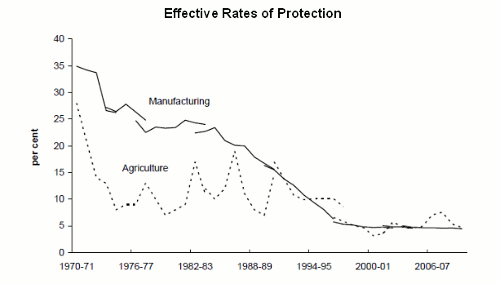Developments in Australian Trade Policy
The Productivity Commission (PC) annually undertakes comprehensive estimates of industry protection, which combine tariffs and other forms of support. The following diagram illustrates the changes in Australia's "effective rate of protection." This measures the assistance on the local value-added (that is, if the tariff is 10 per cent and local value-added is 75 per cent, the effective rate is 10/75 or 13.3 per cent).

The PC's measure of assistance does not cover all forms of subsidy. However, many of the measures it excludes have also been reduced over the past three decades. This is true of government purchasing preferences, local content arrangements, air travel, anti-dumping and countervailing measures, agricultural marketing arrangements, rural support programs and resource access arrangements relating to mining, forestry and fisheries.
Advertisement
The two stand out areas of protection are textiles clothing and footwear, with support at 13 per cent (down from 20 per cent in 2003) and motor vehicles and parts at 11 per cent (down from 17 per cent in 2003).
Pressures for Trade Protection
There are always pressures to provide greater support for a local industry. These come either as a means of offering it a platform on which it might develop economies of scale, often referred to as 'pic king winners,' or as a means of preventing it from being out-competed by imports.
In Australia the former approach has never lacked sponsors. Indeed, even protection for clothing, footwear and motor vehicles started life as industry development plans. Later schemes favoured IT industry areas.
More recently, industry development plans have focussed on green power (where state and federal support has been extended to areas like turbine blade factories that politicians and lobbyists claim to be promising). The Government's carbon tax package includes a $1.2 billion program in subsidies to these developments.
Pressures for protection in the home market occur throughout manufacturing and the intensive agricultural areas and are particularly strong when exchange rates make imports cheaper. Steel, motor vehicles, clothing and horticultural products (where quarantine is used as a non-tariff barrier) are presently receiving or seeking political favours. While government support for activities that are failing as a result of competitive pressures could reverse their fortunes, successful cases are hard to identify.
There is no example of a developed country increasing its relative success while de-liberalising its import markets.
Advertisement
Protection through tariffs and other barriers has however been present during the industrial growth periods of most major countries from the US onwards (where tariff increases sparked off the Civil War). Protection of local production from imports was a significant policy measure in the rapid growth phases of Japan, Korea, and Taiwan though less important for Singapore and totally absent for Hong Kong.
Tariffs were also prominent (and, though they have been reduced, remain so) for China. In the case of India, although tariff levels are double those of Australia, the nation's recent growth was triggered by deregulation, including declining levels of external protection.
Eastern European EU members have also seen rapid growth and have attracted manufacturing investment, while eliminating import protection vis-à-vis their EU partners.
Discuss in our Forums
See what other readers are saying about this article!
Click here to read & post comments.
53 posts so far.